- Read
about the hand-made woollen products of Uttarakhand and how Chikankari is made.
Weaving
is undoubtedly one of those traditional crafts that are deeply connected with
the lives of the hill people. Famous for its woollen fabrics, the Himalayan
weaving tradition in Uttarakhand also produces beautiful cotton and silk goods.
Largely, it is the Bhotia Himalayan weavers’ community which dominates the weaving industry of Uttarakhand. Apart from the Bhotiyas, there are also other weaver communities like the Rompas and the Kolees. The industry turns out a great variety of hand-woven products like socks, caps, scarves, sweaters, mufflers, shawls etc.
Textile
designs are handed down from generation to generation. At times, the
motifs used by weavers show interesting influences of the neighbouring regions
like Tibet, Nepal and China. However, in spite of these influences, the
traditional handlooms of Uttarakhand reflect a unique ethnic character of their
own.
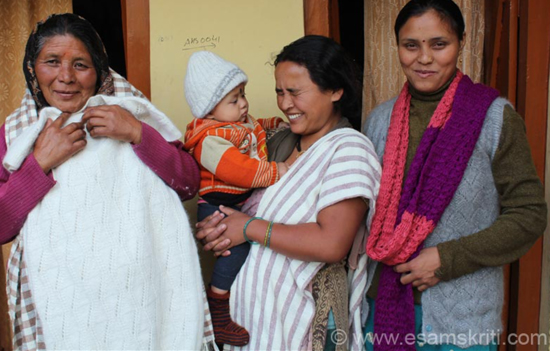 Mother, daughter village Darkot, Munsyari Kumaon.
Mother, daughter village Darkot, Munsyari Kumaon.
The
Himalayan climate of Uttarakhand and the local sheep rearing practices have
largely contributed to the natural development of the woollen industry in the
region. The weavers are mostly rural women who produce beautiful hand-woven
products. In village Darkot, they weave only rabbit wool products. Weaving
comes to locals naturally, can weave whilst watching TV or talking.
Every
year, Bhotiya weavers spend the winter months in Dunda in weaving their clothes
and the summer months in selling those clothes in different seasonal fairs and
tourism sites of Uttarakhand. Some spend summers harvesting fields in Harsil. Those
in Dunda of the Uttarkashi district weave gorgeous traditional patterns on
their crude upright or pit looms, using Charkha-spun wools.
Traditionally
Bhotiya weavers rear their own sheep for wool in the grazing plains of Harsil.
In the winter, when the sheep grow fat and have fully gown hair, the Bhotiyas
come down to Dunda to begin their weaving activities. The Dunda
weaving cluster in Uttarakhand is famous for
carpets and pashmina shawls.
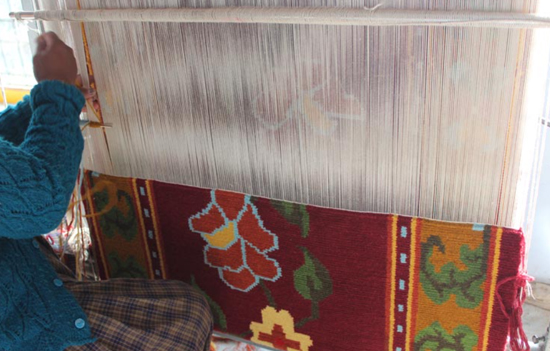 Being trained to weave carpets, Munisyari Kumaon
Being trained to weave carpets, Munisyari Kumaon
The rugs and pashmina shawls of Munsyari are also widely acclaimed. Like Dunda, it is another significant site of the traditional Bhotiya weaving. Munsyari produces some of the finest cashmeres in the world. The dunn which is a type of rug and the thulma – a unique bedspread – made by the Bhotiya weavers of this scenic town in Kumaon. To see album
on Munsyari
You
get soft and warm rabbit wool head caps in Munsyari. Do buy many because you
will not such quality and price elsewhere.
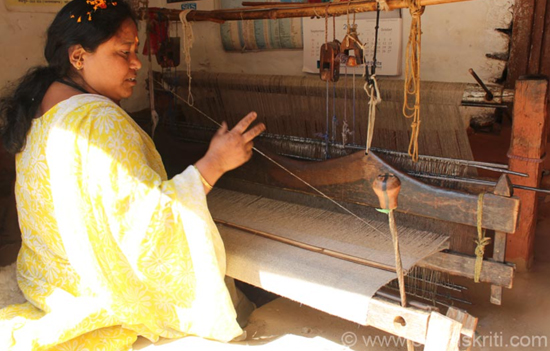 Weaving Pashmini Shawl, village Darkot, Munsyari Kumaon.
Weaving Pashmini Shawl, village Darkot, Munsyari Kumaon.
Gorgeous
pashmina shawls are also produced by the local weavers at the shawl factory of
Kausani. Kausani shawls and stoles have become quite a legend among tourists
and craft-enthusiasts. The shawls are made of superfine Angora rabbit wool and
come with a variety of designs ranging from simple colour patterns to lavish
embroidery works.
Embroidery
The
term embroidery is basically defined as the method of ornamenting a piece of
clothing with needlework; or embellishment with fanciful details. Thus,
embroidery is regarded as the art of decorating textiles using a needle and
thread.
Embroidery
of Uttarakhand has earned its fame because of the versatility of creations. The
artisans use an array of stitches to decorate the items. The most important
centre of embroidery work is located in the Mandalsera,
district Bageshwar.
The
embroidery of Uttarakhand is one of the main sources of income for different
other communities. Designs go back to earlier times or modern geometric designs.
But embroidery continues to be one of the common ways of decorating clothes. In
fact, specialists feel that today there is much more scope for creativity and
innovation, because of the acceptance levels.
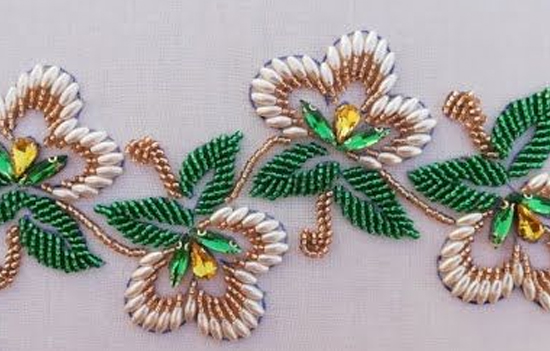 Embroidery Mandalsera.
Embroidery Mandalsera.
This
has ornamentation of tikris and beads, which make them, look attractive. This
type of embroidery is done on a frame of wooden beams. The fabric is worked
upon with a long needle, threads, tikris and beads.
Multi-sized
frames are used, usually about 1.5 feet high, to secure the cloth on which the
design is sketched with a stencil. One hand secures the thread under the cloth
to the needle while the other moves the needle on top of the cloth with ease. Decorative
tikris and beads are attached to the cloth with the needle.
Another
embroidery pattern is the jaali or net
embroidery in geometric or floral shapes and is done by pulling the warp and
weft threads and fixing them with minute buttonhole stitches. The finished
products dominantly comprise items for household use like curtains, bedspreads,
furniture covers and dress material.
Raw Materials used
The
fabric is worked upon with a long needle, threads, tikris and beads.
Process - Embroidery is
not such a technical craft so process is small like-
“1.The motif is made on the tracing screen for symmetrical marking and uniformity, like the Khaka.
2.
Motifs are marked on the fabric with a marking mixer (liquid) for embroidery
work.
3.
Set the marked fabric very tight from all directions. (Saree, Dress materials etc.).
On Wooden frame (it can be done without frame also).
4.
It will work easier to do embroidery with the help of frame to reduce tension
and get pucker less product.
5.
The desired motif is neatly embroidered with different stitches (Pakko, Kachho,
Soof, Rabari, Kharek etc) to achieve desired motif.
6. The result can be many colours and is easy to make.” Source
Embroidery
designs are prepared by fixing small round shaped mirrors to the material with
the help of the buttonhole stitch, the outline being sketched by hand. Silken
thread is used for the stitching done in stem or herringbone, closely worked. Flowers
and creepers are patterned against a very dark background.
Techniques
Techniques vary with the community and region. The term embroidery is defined as the method of ornamenting a piece of clothing with needlework; or embellishment with fanciful details. Thus embroidery is regarded as the art of decorating textiles using a needle and thread. This includes the hand and machine embroidery methods. Till date, hand embroidery continues to be an expensive and time-consuming method. However, in spite of this it is preferred because of the intricacy of the handiwork involved.
The
purpose of this compilation is to document and promote. We have given credits
and reference links in this compilation along with third party links (to
promote). In case some are missed, it is not with malafide intent. Please
email full details to esamskriti108@gmail.com
and we shall effect the change.
Reference and do
read Fabric Tour of India
Himadri Hans Handloom by Hans Foundation – nice
Excellent
Handwoven Woollens at UMANG, Raniket. To see pics
CHIRAG
NGO, Mukteshwar too has very good woollens. See pics 17
to 21
Handlooms of Uttar
Pradesh
We
present Chikankari Embroidery below, Benarasi Saris covered in a separate
article on esamskriti find link below.
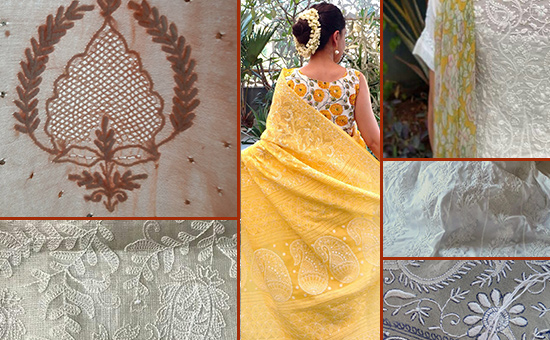 Chikankari Embroidery.
Chikankari Embroidery.
Famous
as shadow work, Chikankari embroidery is a very delicate and intricate work
from the city of Lucknow. A skill more than 200 years old, the embroidery is
famous for its timeless grace and gossamer delicacy. Also known as Chikan, the
embroidery is traditionally done using a white untwisted cotton thread on
colourless muslin popularly known as Tanzeb
(the Muslim from Dacca).
This form of embroidery came to India from Persia with Noor Jehan, the queen of the Mughal Emperor Jehangir. It is also said that the word chikan is a derivative from the Persian word ‘chikaan’ meaning drapery. The craft flourished under the benign Nawabi influence and later with the British influence designs became more formal resulting in an export market in Europe and England.
Read
about and see lovely personal pictures of Where to buy Chikankari in Lucknow
Material
Originally,
chikan embroidery was done with the untwisted white cotton thread on soft,
white cotton fabric like muslin or cambric. It was sometimes done on net to
produce a kind of lace. Today chikan work is not only done with coloured
threads but on all kinds of fabrics like silk, crepe, georgette, organdie
chiffon, and tassar.
Technique
In
Chikankari, the design to be embroidered is printed on the fabric using wooden
blocks dipped in fugitive colours, which are commonly made by mixing a glue and
indigo with water. For extra fine designs, brass-blocks are used sometimes.
Chikankari
flat stitches with their traditional names are:
1. Bukhia: Most
common chikan stitch to get the effect of shadow work. Bukhia is very similar
to the herringbone stitch done on backside and front side to give a shadow effect.
It is done in two ways
a)
From back side (ulta bakhia), the floats lie on the reverse of the fabric
underneath the motif. The transparent muslin becomes opaque and provides a
beautiful effect of light and shade.
b)
From front side (sidha bakhia), it is the satin stitch with criss-crossing of
individual threads. The floats of thread lie on the surface of the fabric. This
is used to fill the forms and there is no light or shade effect.
2. Taipchi: It is
the running stitch worked on the right side of the fabric. It is occasionally
done within parallel rows to fill petals and leaves. Sometimes taipchi is used
to make the bel buti all over the fabric. This is the simplest chikan stitch
and often serves as a basis for further embellishment. It resembles jamdani and
is considered the cheapest and the quickest stitch.
Pechni:
It is the variation build on Taipchi where the taipchi base is covered by
entwining the thread over it in a regular manner thus forming a lever spring.
3. Gitti: A
combination of buttonhole and long satin stitch, usually used to make a
wheel-like motif with a tiny hole in the center.
4. Jangira: It is
the chain stitch usually used as outlines in combination with a line of pechni
or thick taipchi. Chikankari knotted, embossed stitches with their traditional
names are:
a.
Murri: It is the diagonal satin stitches worked several times with a knot on a
basic taipchi stitch to form a grain shape.
b.
Phanda: It is a smaller shortened form of murri. The knots made are spherical
and very small. It resembles millets, gives a raised effect and is used to fill
petals and leaves.
c.
Dhum patti: It is the leaf pattern made of cross-stitch.
d.
Ghas patti: It is the grass leaves formed by V-shaped line of stitches worked
in a graduated series on the right side of the fabric.
Besides
there are two other important forms of embellishments:
1.
Jali work: The jaalis or trellises
that are created in chikankari are a unique speciality of this craft. It gives
an effect of open mesh or net created by carefully pushing warps and wefts
apart by needle without cutting or drawing of thread.
2.
Khatawa: It is an applique work similar to bakhia, which produces a flat
effect. It is more of a technique than a stitch.
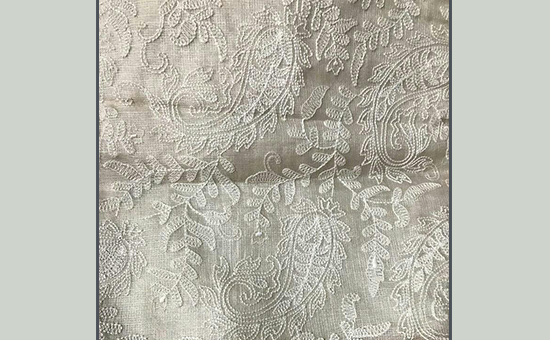 Avoid Machine replica of Chikan.
Avoid Machine replica of Chikan.
Motifs
The source of most of the design motifs in Chikankari is Mughal. Noor Jehan’s personal preferences and desire to replicate the Turkish architectural open-work designs is said to have that led to the introduction of jaalis in chikan embroidery. The designs in chikan are graded and used according to the stitches employed – murri ka buta and tepchi ka jaal-though terms like hathi (elephant) and kairi (mango) are also used to signify the shape of the motif. It is however the stitch employed that is the established nomenclature. Other common motifs include mostly paisley, flowers, foliage’s, creepers, fruits, birds like peacock and parrots.
Reference
and read Chikankari of Uttar Pradesh
Good
read on Chikan
To see a video on making of
Chikankari products
Your
Ultimate guide on Where to buy Chikankari products in Lucknow, how to avoid
buying fake Chikan written by a Lucknow girl
Another
famous hand woven product from Uttar Pradesh is Banarsi Saree. Read all about
it HERE
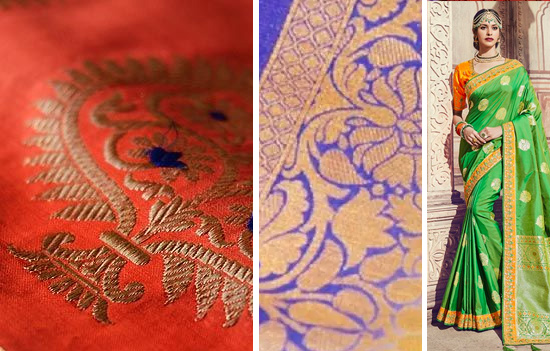 Banarsi Saree.
Banarsi Saree.
To read all
articles by author
To
read all articles on Traditional Indian Textiles of India
Author Trishna
Patnaik
is a self-taught artist based in Mumbai, Trishna has been practising art for over 14 years. She is now a full-time professional painter pursuing her passion to create and explore to the fullest. She conducts painting workshops across India. She is also an art therapist and healer who works with clients on a one to one basis. Not to forget her quality writings on Indian Art and now Textiles for esamskriti. She fancies the art of creative writing.